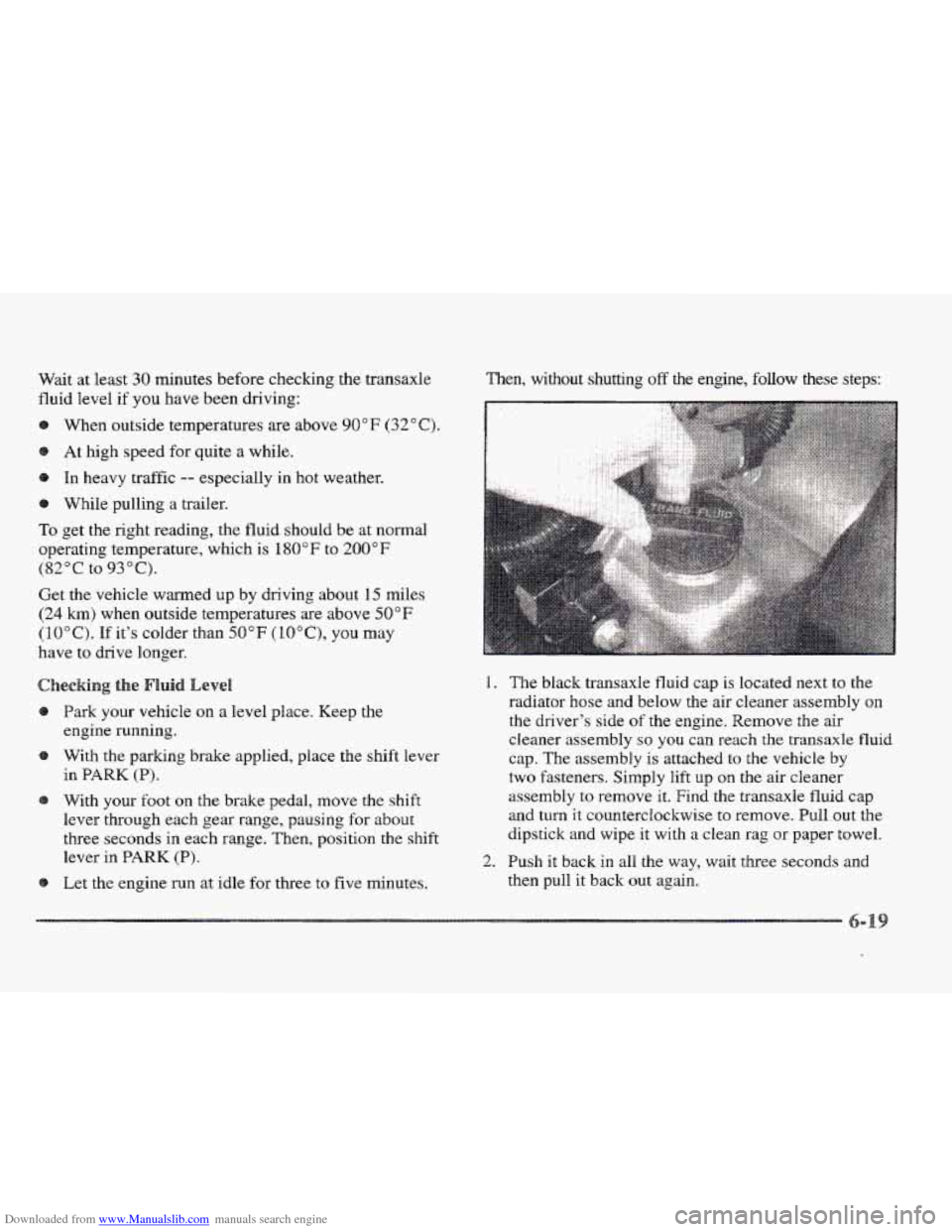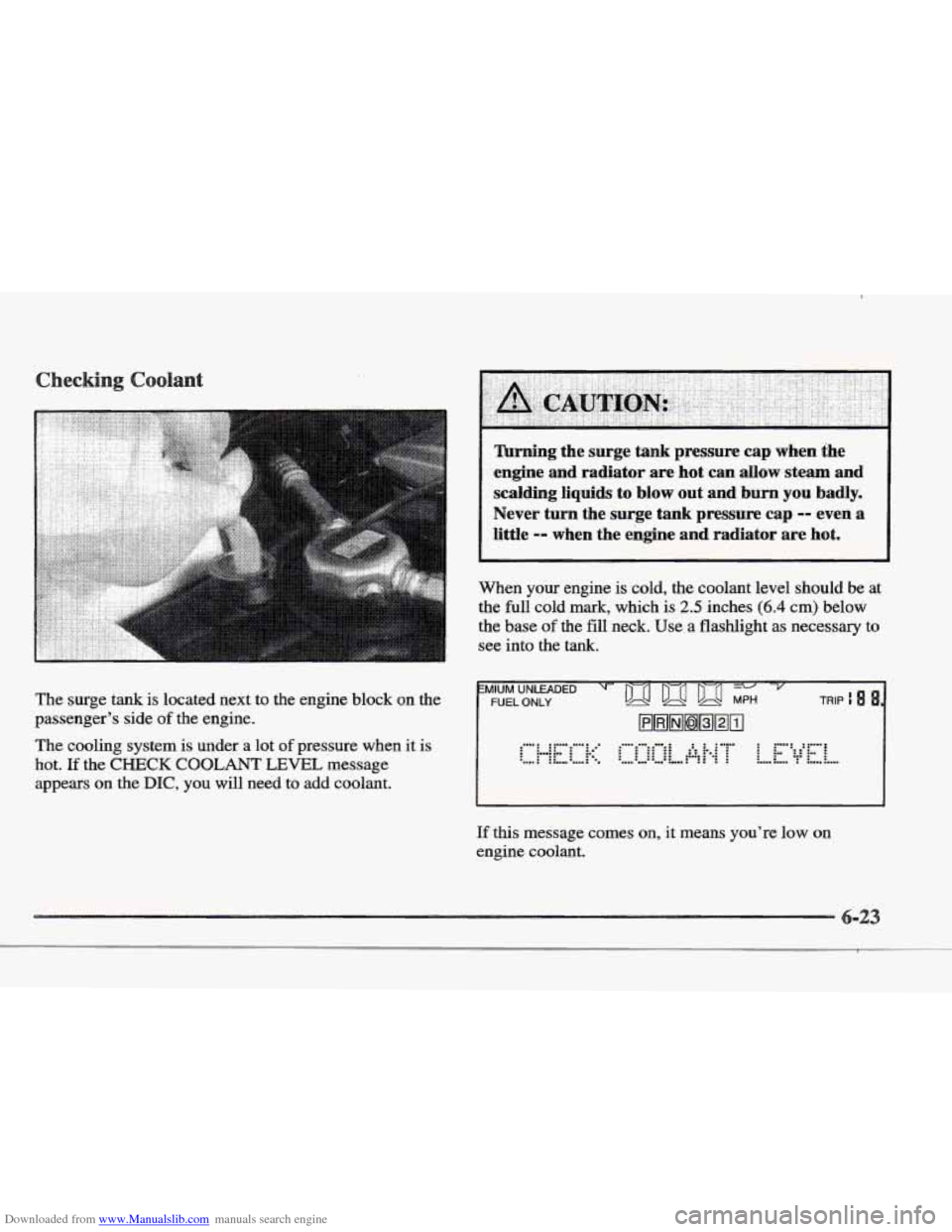Page 248 of 361
Downloaded from www.Manualslib.com manuals search engine I NOTICE:
In cold weather, water can freeze and crack the
engine, radiator, heater core and other parts.
So
use the recommended coolant.
You can be burned if yoa Spill coolant on hot
engine parts. Coolant contains ethylene glycol
and
it will burn if the engine parts are hot
enough.
Don’t spill coolant on a hot engine.
1. You can remove the coolant surge tank pressure cap
when
the cooling system, including the coolant surge
tank pressure cap and upper radiator hose, is
no
longer hot. Turn the pressure cap slowly
counterclockwise until
it first stops. (Don’t press
down while turning the pressure cap.)
If you hear a hiss, wait for that to stop. A hiss means
there is
still some pressure left.
-23
Page 250 of 361
Downloaded from www.Manualslib.com manuals search engine 4. With the coolant surge tank pressure cap off, start the
engine and let
it run until you can feel the upper
radiator hose getting hot. Watch out
for the
engine fans.
By this time, the coolant level inside the coolant
surge tank
may be lower. If the level is lower, add
more of the proper mix to the coolant surge tank
until the level reaches about 2.5 inches (6.4 cm)
below
the base of the filler neck.
5. Then replace the pressure cap. Be sure the ~QWS on
Start the engine and allow it to warm up. If the CHECK
COOLANT LEVEL message does not appear on the
Driver Infomation Center, coolant is at the proper fill
level. If a CHECK COOLANT LEVEL message does
appear, repeat Steps 1 through 3 or see your dealer.
the pressure cap line up like this.
-2
Page 275 of 361
Downloaded from www.Manualslib.com manuals search engine The oil fill cap is located
behind the radiator
on the
passenger’s side
of the
engine.
Turn the cap
counterclockwise to
remove it.
Be sure to fill it enough to put the level somewhere in
the proper operating range. Push the dipstick all the way
back
in when you’re through.
at
Oils recommended for your vehicle can be identified by
looking for the “Starburst” symbol. This symbol
indicates that the oil
has been certified by the American
Petroleum Institute
(AH). Do not use any oil which
does not
carry this Starburst symbol.
If you change your own oil,
be sure you use
oil that has
the Starburst symbol on the
front
of the oil container.
If you have your oil changed for you, be sure the oil put
into your engine is American Petroleum Institute
certified
for gasoline engines.
You should also use the proper viscosity
oil for your
vehicle,
as shown in the following chart:
Page 282 of 361

Downloaded from www.Manualslib.com manuals search engine Wait at least 30 minutes before checking the transaxle
fluid Bevel
if you have been driving:
When outside temperatures are above
90" F (32 " C).
At high speed for quite a while.
In heavy traffic
-- especially in hot weather.
While pulling
a trailer.
To get the right reading, the fluid should be at normal
operating temperature, which
is 180°F to 200" F
(82°C to 93°C).
Get the vehicle warmed up by driving about 15 miles
(24 km) when outside temperatures are above 50°F
(10°C). If it's colder than 50°F ( 10°C), YSU may
have to drive longer.
Park your vehicle on a level place. Keep the
engine running.
With the parhng brake applied, place the shift
lever
in PARK (P).
With your foot on the brake pedal, move the shift
lever through each gear range, pausing for about
three seconds
in each range. Then, position the shift
lever in
PARK (P).
Let the engine run at idle for three to five minutes. Then, without shutting
off the engine, follow these steps:
1.
2.
The
black transaxle fluid cap is located next to the
radiator hose and
below the air cleaner assembly on
the driver's side of the engine. Remove the air
cleaner assembly
so you can reach the transaxle fluid
cap. The assembly
is attached to the vehicle by
two fasteners. Simply lift up on the air cleaner
assembly to remove it.
Find the transaxle fluid cap
and
turn it counterclockwise to remove. Pull out the
dipstick and wipe it with
a clean rag or paper towel.
Push it back in all the way, wait three seconds and
then pull it back out again.
Page 286 of 361

Downloaded from www.Manualslib.com manuals search engine The surge tank is located next to the engine block on the
passenger's side
of the engine.
The cooling system is under a lot
of pressure when it is
hot. If the CHECK COOLANT LEVEL message
appears on the
DIC, you will need to add coolant.
Turning the surge tank pressure cap when the
engine and radiator are hot can allow steam and
scalding liquids to blow out and burn you badly.
Never
turn the surge tank pressure cap =- even a
little -- when the engine and radiator are hot.
When your engine is cold, the coolant level should be at
the full cold mark,
which is 2.5 inches (6.4 cm) below
the base
of the fill neck. Use a flashlight as necessary to
see into the
tank.
MlUM UNLEADED - -
FUEL ONLY
DS Dg a ML
HHBHBBrn
........... ....... ." .......................... ...... ....... , : :: :: .-. :. : : ............. :.no. ... ..... : :L...-"..: ".L... ..... .............. .....
.... ...... ............ . .. . .I ......... .... . . -. . . .".. .".. .I.. ..". ." ...
If this message comes on, it means you're low on
engine
coolant.
Page 287 of 361
Downloaded from www.Manualslib.com manuals search engine Adding Coolant
If you need more coolant, add the proper DEX-COOL@
coolant mixture at the surge tmk, but only when the
engine is cool.
You can be burned if you spill coolant on hot
engine parts. Coolant contains ethylene
glycol,
and it will burn if the engine parts are hot
enough.
Don’t spill coolant on a hot engine.
When replacing the pressure cap, make sure it is tight.
The surge tank cap is a I§ psi (105 ma)
pressure-type cap and must be tightly installed
to prevent coolant loss and possible engine
damage from overheating. Be
sure the arrows
If the surge tank pressure cap needs to be replaced, a
General Motors cap is recommended.
e
Engine coolant temperature is controlled by a thermostat
in the engine coolant system. The thermostat stops the
flow of coolant through the radiator until the coolant
reaches a preset temperature.
If your thermostat needs to be replaced, a General
Motors thermostat is recommended.
-2
Page 289 of 361
Downloaded from www.Manualslib.com manuals search engine The windsheld washer fluid reservoir is located next to
the air cleaner on the driver’s side of the engine.
Open the
cap labeled WASHER FLUID ONLY. Add
washer
fluid until the tank is full. When
using concentrated washer fluid,
follow the manufacturer’s instructions for
adding water.
Don’t
mix water with ready-to-use washer
fluid.
Water can cause the solution to freeze
and damage YOUS washer fluid tank and
other parts
of the washes system. Also,
water doesn’t clean
as well as washer fluid.
Fill your washer fluid tank only
three-quarters full when it’s very cold. This
allows for expansion if freezing OCCUTS,
which could damage the tank if it is
completely fulll.
Don’t use radiator antifreeze in your
windshield washer. It can damage your
washer system
and paint.